| Srl | Item |
| 1 |
ID:
053395
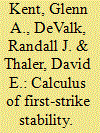

|
|
|
|
|
| Publication |
Santa Monica, Rand Corporation, 1988.
|
| Description |
39p.
|
|
|
|
|
|
|
|
|
|
|
|
Copies: C:1/I:0,R:0,Q:0
Circulation
| Accession# | Call# | Current Location | Status | Policy | Location |
| 030047 | N-2526-AF/KEN 030047 | Main | On Shelf | General | |
|
|
|
|
| 2 |
ID:
145947
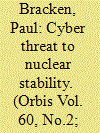

|
|
|
|
|
| Summary/Abstract |
The thesis of this article is that cyber war technologies are spilling over into precision strike and nuclear mission areas. The result will transform deterrence and arms race stability and lead to other significant changes. The driver behind this is a combination of long standing problems with mobile missiles along with new technologies not usually factored into strategic assessments: big data analytics, computer vision, and related information systems. When combined with drones and precision strike, the hunt for mobile missiles is becoming faster, cheaper, and better. The implications of this finding vary by country, but will shape major power nuclear modernization, crisis stability among secondary powers, and conventional attack of nuclear deterrents.
|
|
|
|
|
|
|
|
|
|
|
|
|
|
|
|
| 3 |
ID:
056433
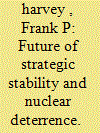

|
|
|
| 4 |
ID:
099948
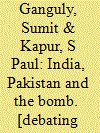

|
|
|
|
|
| Publication |
New Delhi, Penguin Group, 2010.
|
| Description |
x, 132p.
|
| Standard Number |
9780670084753, hbk
|
|
|
|
|
|
|
|
|
|
|
|
Copies: C:2/I:0,R:0,Q:0
Circulation
| Accession# | Call# | Current Location | Status | Policy | Location |
| 055441 | 327.17470954/GAN 055441 | Main | On Shelf | General | |
| 055901 | 327.17470954/GAN 055901 | Main | On Shelf | General | |
|
|
|
|
| 5 |
ID:
061278
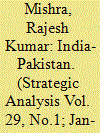

|
|
|
|
|
| Publication |
Jan-Mar 2005.
|
|
|
|
|
|
|
|
|
|
|
|
|
|
|
|
| 6 |
ID:
054604
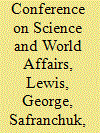

|
|
|
|
|
| Publication |
Sigtuna, Pugwash, 2000.
|
| Description |
100p.
|
| Series |
Pugwash occasional papers; no.2
|
|
|
|
|
|
|
|
|
|
|
|
Copies: C:1/I:0,R:0,Q:0
Circulation
| Accession# | Call# | Current Location | Status | Policy | Location |
| 044301 | 358.17/NUC 044301 | Main | On Shelf | General | |
|
|
|
|
| 7 |
ID:
193539
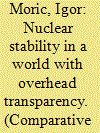

|
|
|
|
|
| Summary/Abstract |
The increasing number of Earth observation satellites are introducing a revolution in overhead transparency and making ground activity more visible than ever before. In the near future, swarms of satellites will provide imagery which is persistent, high-resolution, delivered in real-time and widely accessible. This data will be instantly and autonomously analyzed by artificial intelligence, and insights provided to users. In the global security environment defined by rising great power competition, increased transparency could have a significant impact on nuclear stability by breaking the secrecy nuclear weapon states rely on. This could stimulate a dangerous nuclear arms race. If political conditions align and states make that choice, new technological capabilities could also help create an environment of trust and predictability and facilitate the next generation of arms control.
|
|
|
|
|
|
|
|
|
|
|
|
|
|
|
|
| 8 |
ID:
162080
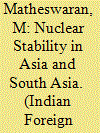

|
|
|
| 9 |
ID:
083702


|
|
|
|
|
| Publication |
2008.
|
| Summary/Abstract |
An examination of the onset, evolution, and termination of the 1999 and 2001-02 crises between India and Pakistan suggests that nuclear deterrence is robust in South Asia. Even though the 1999 crisis erupted into a war, its scope and dimensions were carefully circumscribed. Despite its conventional capabilities, India chose not to cross the Line of Control (the de facto international border in the disputed state of Jammu and Kashmir), and it avoided horizontal escalation of the conflict. India's restraint cannot be attributed either to timely U.S. intervention or to a concern about avoiding a bellicose international image. Instead a highly jingoistic regime, which had defied international public opinion the previous year through a series of nuclear tests, chose to exercise restraint because of Pakistan's possession of nuclear weapons. In 2001, despite grave Pakistani provocation through a series of terrorist attacks, India could only respond with a strategy of coercive diplomacy.
|
|
|
|
|
|
|
|
|
|
|
|
|
|
|
|
| 10 |
ID:
170575
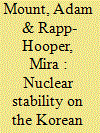

|
|
|
|
|
| Summary/Abstract |
he US and South Korea must afford Pyongyang a rational expectation of security but no hope of winning a limited conflict.
|
|
|
|
|
|
|
|
|
|
|
|
|
|
|
|
| 11 |
ID:
065663
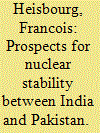

|
|
|
|
|
| Publication |
1998.
|
| Description |
p.77-92
|
|
|
|
|
|
|
|
|
|
|
|
|
|
|
|
| 12 |
ID:
140978


|
|
|
|
|
| Summary/Abstract |
While recent history arguably demonstrates a high level of nuclear stability in South Asia, this article argues that this stability has historically been a function of India's relative weakness. It argues that, as India becomes stronger, attention must be paid to the technical and political requirements of nuclear stability: the reliability of weapons and command and control and the political conditions that underpin stable relations between nuclear-armed states. It concludes by recommending the United States aim to modify the perceptions of regional elites about their various intentions and decision-making processes and the role of the United States as crisis manager.
|
|
|
|
|
|
|
|
|
|
|
|
|
|
|
|
| 13 |
ID:
088515
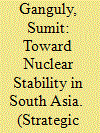

|
|
|
|
|
| Publication |
2009.
|
| Summary/Abstract |
Contrary to the arguments of proliferation pessimists, this article contends that the overt nuclearization of South Asia has contributed to stability in the region. To that end this article carefully examines two recent crises in Indo-Pakistani relations and concludes that in the absence of nuclear weapons they would have culminated in full-scale war. Accordingly, while Indo-Pakistani relations may remain fraught with tension, the likelihood of major war in the region has dramatically diminished.
|
|
|
|
|
|
|
|
|
|
|
|
|
|
|
|
| 14 |
ID:
177881
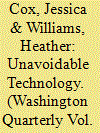

|
|
|
|
|
| Summary/Abstract |
Artificial intelligence (AI) is developing at a rapid pace—both the technology itself and its applications. It is becoming unavoidable in both the civilian and military domains and will soon impact numerous areas of civilian and military life. In July 2020, for example, countries such as Colombia and Russia applied facial recognition technology, a form of artificial intelligence, to combat the coronavirus by detecting whether someone was not wearing a mask or had a high temperature through the use of thermal cameras and sounding an alarm.
|
|
|
|
|
|
|
|
|
|
|
|
|
|
|
|